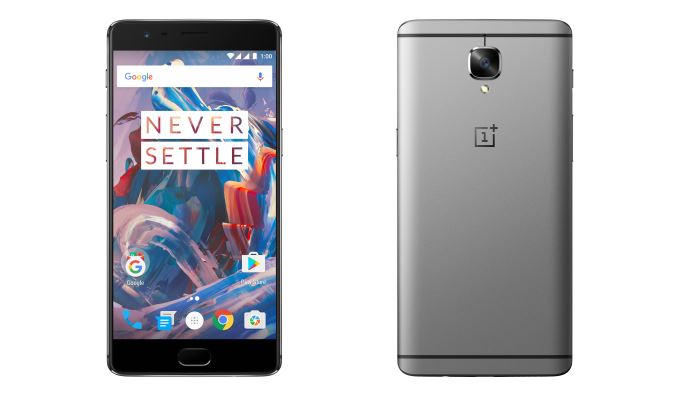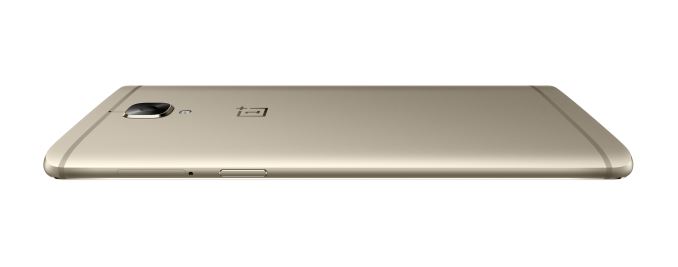OnePlus Launches The OnePlus 3
by Brandon Chester on June 14, 2016 1:00 PM EST- Posted in
- Smartphones
- OnePlus
- OnePlus 3

Today OnePlus announced their newest flagship phone, the OnePlus 3. The OnePlus 3 replaces the OnePlus 2, while the OnePlus X stays around as the less expensive OnePlus device with a smaller display. I reviewed the OnePlus 2 at the end of last year, and unfortunately I was forced to conclude that it actually represented a significant downgrade from its predecessor in many ways. Some of this was due to choices OnePlus had made with the product design, such as the very poor display calibration. Others were out of their control, like the throttling issues on Qualcomm's Snapdragon 808 and 810 SoCs. A combination of these factors led to a smartphone that just wasn't able to compete in an increasingly competitive market.
With the OnePlus 3 OnePlus has a chance to fix the issues with the OnePlus 2 and once again offer a compelling smartphone at a price lower than that of the flagship smartphones sold by the larger Android OEMs. To accomplish this, OnePlus has made very large changes on both the inside and the outside, making the OnePlus 3 the largest jump that a OnePlus smartphone has made to date. You can check out the specs of the OnePlus 3 compared to its predecessor in the table below.
| OnePlus 2 | OnePlus 3 | |
| SoC | Qualcomm Snapdragon 810 | Qualcomm Snapdragon 820 |
| GPU | Adreno 430 | Adreno 530 |
| RAM | 2/4GB LPDDR4 | 6GB LPDDR4 |
| Display | 5.5" 1920 x 1080 IPS LCD | 5.5" 1920 x 1080 PenTile AMOLED |
| Size / Mass | 151.8 x 74.9 x 9.85mm, 175g | 152.7 x 74.7 x 7.35mm, 158g |
| Battery | 3300 mAh | 3000 mAh |
| Rear Camera | 13MP 1.3 μm OmniVision OV13860 f/2.0 | 16MP 1.1 μm Sony IMX298, f/2.0, OIS |
| Front Camera | 5MP 1.4 μm OmniVision OV5648, f/2.0 | 8MP 1.4 μm Sony IMX179, f/2.0 |
| Storage | 16/64GB eMMC | 64GB UFS 2.0 |
| I/O | USB 2.0 Type-C connector, 3.5mm audio | |
| Connectivity | 802.11a/b/g/n/ac + BT 4.1 USB-C, GPS/GNSS |
802.11a/b/g/n/ac + BT 4.2, USB-C NFC, GPS/GNSS |
| Price | $329 (3GB/16GB) $389 (4GB/64GB) |
$399 (6GB/64GB) |
OnePlus advertises that the OnePlus 3 is 35% faster with CPU tasks and 40% faster with graphics tasks. We've seen that Snapdragon 820 provides significant improvements in performance over Snapdragon 810, especially with Snapdragon 810's throttling problems. In the case of the OnePlus 3, they're probably selling themselves short with these figures due to the OnePlus 2's power management mechanism which completely disables the A57 cores when web browsing, along with the fact that it used an underclocked Snapdragon 810 that didn't stand up well under any sort of prolonged load.
In addition to the SoC bump, OnePlus has gone all out with the RAM. The OnePlus 2 came in a 2GB and a 4GB version, although I mostly only saw the 4GB model for sale. With the OnePlus 3 they include 6GB of LPDDR4 RAM in every model, which is ahead of pretty much everything else in the smartphone market and probably more than you'll need on a phone for many years. As for storage, every model is 64GB now, and OnePlus is now using UFS 2.0 NAND instead of eMMC, which makes the remaining flagship vendors using eMMC look rather awkward in the market given that the OnePlus 3 comes in at under $400.
The display maintains its size and resolution, but OnePlus has moved to an AMOLED panel and is targeting the NTSC color gamut. Unfortunately, neither of these things seem like improvements, with the effective resolution of red and blue on the panel now being halved, and the color gamut not conforming to the sRGB standard as it should. I'll be putting the OnePlus 3 through our standard display workflow with the full review, and if you value an accurate display I would wait until that time before you make up your mind about buying the phone.
OnePlus has moved back to Sony sensors for the cameras on the OnePlus 3. What I find interesting but potentially concerning is that the sensor size has actually gone down, and although resolution has gone up the pixel size has decreased from 1.3 micron to 1.12 micron. However, differences in sensors can have various impacts on their characteristics, and the OnePlus 2 had some significant issues with image processing which means it's still very possible that the OnePlus 3 has improved with respect to image quality. However, it does seem like a concession made to reduce the camera hump on the relatively thin chassis, which some buyers may disagree with as a design choice.
OnePlus has moved to an aluminum unibody design with the OnePlus 3, and it's pretty great. I was really not a fan of the sandstone finish on the OnePlus One and OnePlus 2, which I frankly thought felt cheap and didn't even add much in the way of grip because it wasn't coarse enough. The OnePlus 2 introduced a metal frame, but it didn't do much to improve the feel of the phone. Along with the move to a full aluminum unibody comes a dramatic reduction in thickness and mass, which makes it significantly more comfortable to use for long periods of time than the OnePlus 2. While I'll cover the design in more detail in my review, I can say for certain that I like the design very very much as both an improvement over the OnePlus 2 and a design that is just good in its own right.
My review of the OnePlus 3 is already well underway, and it will be going up next week. There's a lot more to the OnePlus 3 than what you see on a spec sheet, and some of the choices that OnePlus has made to balance aspects like thickness and mass against battery capacity and camera sensor size make for some interesting changes going from a previous OnePlus smartphone to the OnePlus 3.
The last thing of note is that OnePlus has done away with the invite system. I personally thought the invite system was a ridiculous and terrible idea that only caused problems for people who wanted to buy the phone, and I think this is a big step forward for OnePlus as a company. After three generations they likely have a better idea of how many orders to expect, which may have been a contributing factor in deciding to do away with the invite process. Right now the OnePlus 3 comes in a graphite finish, and it will come in a gold finish soon after release. If you already know that you want the OnePlus 3 and want to buy it before anyone else, you can get it from OnePlus's online store for $399 USD.












76 Comments
View All Comments
lmc5b - Tuesday, June 14, 2016 - link
Are you talking about pentile or ppi? I get that 1080p pentile may not be enough for everybody, but full rgb 1080p is a different story.Death666Angel - Thursday, June 16, 2016 - link
I was talking about the fact that most AMOLED 5.5"+ phones with pentile subpixel orientation have a QHD resolution, thus lessening the impact of pentile vs RGB. Was not talking about RGB 1080p.0razor1 - Wednesday, June 15, 2016 - link
Not to cut costs, but ..1. Pentile = longer panel lifespan. They went full RGB with the galaxy S2. They went back to pentile cause the burn in and degradation was too much of collateral.
2. Pentile is also better for battery life. It's the reason why AMOLEDs continue to suck less display panel power as compared to LCDs as the pixel density goes up. Check DXO mark for specifics ( a good example- the Note 4).
3. Pentile makes it easier to cram more pixels into a smaller space. That's why an S6 can have a 1440p display.
They can go full RGB but yes, considering all the above factors, that will be a custom fab request, and will cost buyers more.
Back to the article, 5.5 Pentile FHD is horrible. I had the OG Droid Razor with a 900p pentile panel on 4.7 inches or so, and it sucked.
And @AT, my country's IPs are banned from the forums. I've ignored it for years. It's quite frustrating. Can you do something about it?
rxzlmn - Wednesday, June 15, 2016 - link
I still have an SGS2 and there is no burn-in of any sort and also no sign of 'degradation'. I think it was purely a cost issue / technical issue in manufacturing that made them abandon that subpixel type of panel.mortimerr - Wednesday, June 15, 2016 - link
What makes a pentile amoled at that size and res so bad?Eden-K121D - Sunday, June 19, 2016 - link
Note 7 is rumoured to be Full RGB amoled so is the 2017 iPhone 8? Samsung also indicated they were manufacturing custom equipment for OLED production like custom masks and stuffShadowmaster625 - Tuesday, June 14, 2016 - link
6GB of RAM. lol. I am gonna have to buy this thing just to see if my apps and web pages still are constantly forced to reload even though I am only using 1GB of RAM.nandnandnand - Tuesday, June 14, 2016 - link
Please do so and report back your findings.HyperText - Tuesday, June 14, 2016 - link
I strongly second this, please!3DoubleD - Tuesday, June 14, 2016 - link
There is no battery capacity data in the chart. How big is it?